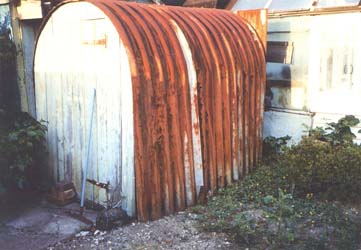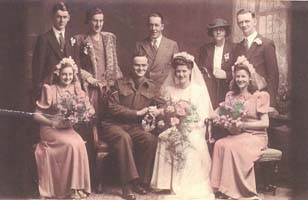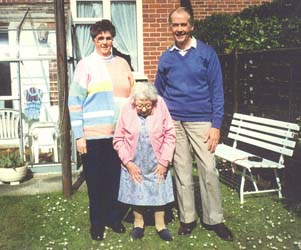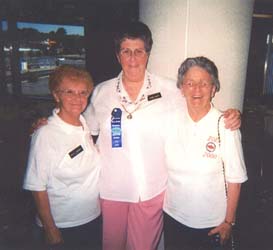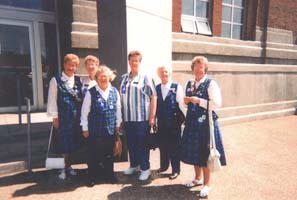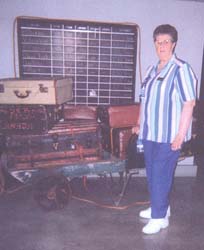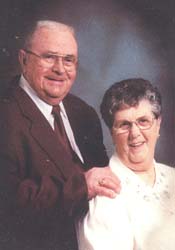Wall of Service
Column
13
Row
23
Editor's Note: The following memoir is based on an interview that was conducted by Elinor Maher and Beverly MacLellan for the Colchester Historical Society Museum & Archives as part of the museums Year of the War Bride research and exhibit of 2006. The Pier 21 Society would like to thank Ms. Maher, Ms. MacLellan and the war brides that contributed to this collection by sharing their experiences and impressions of the war years and their early days in Canada.
Name: Audrey (nee Smith) Pratt
Parents: Dorothy (nee Robinson) and Samuel Smith
Home: Eastleigh, England, which was about 60 miles from London, 5 miles from Southampton.
Birthdate: September 24, 1926
War time memories:
Audrey was only 13 when the war started. In 1940, at the age of fifteen, she began to work in the 'outside contracts' office at the General Cable factory. Pirelli was the main employer in Eastleigh, employing many. Audrey's parents both served at the company social club for special events. Audrey needed her national identification card, a gas mask and a company identification card to be admitted to her workplace.
German bombing was terrible in this part of England. "You could hear them coming from as far away as the White Cliffs of Dover. I could even tell by the sound of their engines that they were the enemy. It had a different drone of the engine. You could see the soldier's eyes in the cockpit - that was how low they flew. We had to get to our shelters anyway we could, anywhere there was one handy. We were bombed in the factory once."
A home near the Smiths was bombed and two of their neighbours killed. That bomb shattered their windowpanes. Most people had a bomb shelter of some kind in their home or garden.
Audrey remembers being annoyed at having to go the air raid shelter almost every night. Her mother would wake the family members to go to the shelter in the bottom of the garden. The government supplied a corrugated metal shell (an Anderson Shelter) and her father buried it so that 3/4 of it was underground in the back of the garden, covering the top with earth and sod for further protection. There were steps down so they could enter through a door. Mr. Smith built three bunks inside for the children and he and his wife slept on mattresses on the floor. It could sleep the family of six. They had to remain inside until they heard the 'all clear' signal.
They had electricity and a kettle in the shelter. At one time the bombing was so steady they slept inside the shelter for three months. This type of shelter could protect against anything but a direct hit. The Smith's shelter was later converted to be a coal shed.
The Smiths watched the bombing of Portsmouth and Southampton.
Britons were awarded 66 coupons per year to buy all of their clothing, outer wear and underwear, shoes and stockings. A dress took 11 coupons, undergarments 3 each, coats and jackets took 13 each. Coupons were used up quickly so new clothes were difficult to come by. Fabric and yarn for knitting were also rationed.
Husband:
Leland M. Pratt of Belmont left Halifax from Pier 21 in May of 1941 aged 17. On board ship Lee was in charge of two grenade guns. When Audrey met Lee he was in the Army Provost Corps [police service]. Previously Lee had served with the North Nova Scotia Highlanders, Artillery and Provost Corps. He was in one of the first boats to land in France on D-Day.
How did you meet your husband?
The couple tell two different stories of how they met but agree it was at a dance in Eastleigh's old town hall. Audrey took a sudden dislike to him. When he asked Audrey out later she said she had to work and was embarrassed when she met him on the street. "He kept coming around and the rest is history."
Lee proposed "on the eve of his departure for Normandy Beaches, June 1944." Because he was underage he had to get permission from his mother to get married and have her send an engagement ring from Canada as he couldn't buy a diamond ring in England.
Wedding date: March 28, 1945
What are your memories of your wedding and the time that followed?
Audrey was 18 at the time of the wedding. Lee was granted a twelve-day leave to be married in March 1945. Audrey was busy working and preparing for the big day. She saved her coupons for the material for the dresses. Coupons for food rations were gathered or given as a wedding gift. The family was able to have the wedding reception at the Pirelli social club. They had a "full sit down meal, consisting of beef tongue and vegetables". She still has the receipt for catering for 45 people at a cost of £819p. Two waitresses brought the food in a taxi.
Audrey's mother made the three girls' dresses. The bridal attendants' dresses were carnation pink and they carried bouquets of irises. Audrey's bouquet was pink carnations and her veil was borrowed from her friend Violet. The veiling fabric featured a series of dots and dashes, representing the Morse code for V [the symbol for Victory].
Following the wedding Lee had a couple more days leave before he returned to France. Two days before VE day Lee and his troop were taken prisoners-of-war. After his release, Lee was stationed in Utrecht, Holland but he got a couple of leaves to visit Audrey before he returned to Canada in January 1946.
In the meantime Audrey remembers, "I was busy attending to getting my blood work done, medical check-ups, passport completed and papers in order to leave England for Canada. I have always had a fascination about Canada and had studied it quite a bit in school so I was getting very excited."
What was your family's reaction to the news you were marrying a Canadian?
Audrey's parents really didn't have a chance to get to know Lee as his army duties took him away so often. Her mother said "You make your bed, you lie on it."
"There was a lot of crying and commotion going on the day we left let me tell you. Amidst the tears and the good-byes, we boarded the HMCS Lady Nelson."
What are your memories of the trip to Canada?
Audrey came on the Lady Nelson and the trip took nine days. The vessel had been a hospital ship during the war. There were 300 war brides and some airmen on board.
"I got very seasick for three days. The first food that I ate was white rolls. Ask any War Bride and they will tell you about getting white rolls on the ship; it was so unlike the grey bread we had to eat back in England."
Audrey recalls she was on the second deck but close to the WC. She shared her cabin with quite a few pregnant women and the man in charge called them all his daughters.
What was the date and memories of your arrival?
August 19,1946
"When we sailed into Halifax harbour and everyone was on deck in anticipation for what lay ahead. When we came ashore in Halifax and looked up the hills all I could see was Christmas trees [evergreens]."
".... we arrived in Halifax on 19 August to clear, sunny skies. I was immediately sent to a big shed on the pier to wait for my husband. One of our companions was told upon arrival that she was 'not wanted' and therefore, would be returned on the next boat. As the minutes ticked by, many of us wondered what our fate would be."
Lee had cabled that he would meet her but he was an hour late because he had car trouble.
Children?
Audrey and Lee had a son born in England who died shortly after birth.
They had two children in Canada:
David - 1949
Darlene - 1951
Darlene has expressed an interest in starting a society for the daughters of war brides to carry on their legacy.
What were your first impressions of Canada?
When they got to Crowes Mills "we stopped at the Mill, (where Leland worked) and I thought 'O my God! I am going to the back woods because there weren't any houses, bar about six!' "
"My second meal in Canada consisted of salt codfish in sauce and potatoes boiled with the skin on! It certainly did not appeal to me at the time. However, I have since discovered that it is quite good. Many other Canadian foods have come my way over the years, but I have not mastered a taste for molasses, cranberries or peanut butter."
Audrey recalls "People were good to us - they didn't treat us like outcasts".
Where did you live after your arrival in Canada?
Lee and Audrey built a small house in Belmont on an acre lot they bought for $200. They nearly froze to death the first winter. They bathed "in front of the stove, in a little round tub. If you bent the wrong way you could burn yourself." Audrey also had problems with the weather, the wood stove and getting used to an outhouse. They didn't have any electricity for a while and used a hand pump for water.
Adjustment to Canadian life:
Audrey recalls she not only relied on her husband but on the support of other war brides. The girls got together to form the War Brides Association. "It helped that I could turn to Winnie MacLeod, my sister-in-law."
"I had a little trouble at first figuring out the value of the dollar, but the hardest thing was telling people what I wanted. Down at the General Store, I remember asking the store owner for a box of 'saoolt' and he would ask me to write it down because he couldn't understand me."
What are the differences in your Christmas memories at home and when you first came to Canada?
"We all gathered at Mom's place for Christmas dinner and we never had a tree until the later years. Dad got a tree that looked like a Charlie Brown tree and planted it in the garden for future Christmases. Here, we always have a fresh Christmas tree every year."
Did you have trips home?
One year Audrey's mother paid her way back to England for a visit. Another visit she took the children home when they were two and four, in 1953. Over the years she has enjoyed other trips through the years with her family.
Did your family come to Canada to visit?
In 1948 Audrey's mother sent her sister Olive over to check up on her.
One Christmas her mother came by boat and surprised her with a visit. Just before Christmas Audrey's daughter Darlene came in and said "There is a gift for you and it's too big for me to keep at my house. Audrey was shocked to see her mother. She went back with her by plane as Mrs. Smith wasn't well. Audrey's father died on December 3, 1973, just before her parents would have celebrated their 50th anniversary.
Did you or your children have difficulties with Canadian. Citizenship?
Audrey remembers very clearly they were told they would automatically become Canadian citizens. In 1982 Audrey applied for a Canadian passport and discovered she was not a citizen. At that time she applied for and received Canadian citizenship.
Looking back:
"I must be honest and admit that life in Canada was certainly a struggle at first. My husband's family was very encouraging and did their best to make me feel welcome, and I soon learned to adapt. I have been very fortunate that I have been able to return to England on many occasions and that my family has been able to come from England to see me. I feel very fortunate that I have two such great countries to call home."
Audrey says, "I wouldn't change a thing. Canada is my home and the home of my family."
